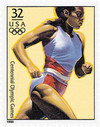US #3068c
1996 Women’s Running
- Part of Souvenir Sheet of 20
- Sheet commemorates 100th anniversary of Olympics
- Fourth sheet in Classic Collections series
Category of Stamp: Commemorative
Set: Olympic Games
Value: 32¢, First-Class mail rate
First Day of Issue: May 2, 1996
First Day City: Washington, DC
Quantity Issued: 324,150,000
Printed by: J. W. Fergusson and Sons, for Stamp Venturers
Printing Method: Photogravure
Format: Panes of 20 (5 across, 4 down) from cylinders of 120 (8 across, 15 down)
Perforations: 10.1
Reason the stamp was issued: The sheet of 20 stamps was issued in honor of the 100th anniversary of the moder Olympic Games. The Olympics were held in Atlanta, Georgia two months later.
About the stamp design: Artist Richard Waldrep created the paintings used for the stamp images using photographs of athletes performing each sport. He chose sports that America was likely to do well in and those that were the most watched on TV.
Waldrep had previously designed the set of five stamps for the 1992 Summer Olympics and the four Country and Western Music stamps the following year.
Special design details: In some of his designs, Waldrep had to alter the faces and uniforms of the athletes he depicted so they wouldn’t resemble the athlete in the original photos he used for reference.
First Day City: Though the First Day of Issue ceremony was originally supposed to be held in Atlanta, it was changed to Washington, DC, just weeks before the stamp was issued. This was in response to a disagreement between the US Postal Service and the US Olympic Committee over the sale of T-shirts picturing the stamps. The Olympic Committee saw the merchandise as a violation of the marketing agreement between the committee and the USPS.
About the Classic Collections Series: The Atlanta 1996 sheet was the fourth issue in the Classic Collections series. This series began in 1994 with the Legends of the West issue. The idea originated from Carl Burcham, manager of stamp and product marketing for USPS at the time. Each Classic Collections set consists of a pane of 20 different semi-jumbo stamps with descriptive selvage at the top (header) and informational text on the back of each stamp beneath the gum. The stamps are “broadly defined, Americana-themed subjects.”
The first four Classic Collections sets were accompanied by matching sets of picture postal cards showcasing the stamp designs.
History the Souvenir Sheet represents: The 1996 Olympic Games marked an important anniversary – 100 years since the start of the modern Olympic Games. The Ancient Olympic Games were held between 776 BC and 394 AD, when Theodosius I abolished them.
More than 1,500 years later, Pierre de Coubertin arranged for the first modern Olympics to be held in 1896. He believed that friendly athletic competition could promote world peace. Those first games consisted of 285 athletes, representing 13 nations, competing in 42 events. The games were a success and became an international tradition.
One hundred years later, the world excitedly prepared for the 1996 Olympic Games. The games opened on July 19, 1996, in Atlanta, Georgia. Some 11,000 athletes from 197 nations competed in hundreds of events.
The US issued two items for the occasion. One was a sheet of 20 stamps (#3068), released in May, that depicted modern athletes. The other was issued on the opening day of the show and honored the games’ centennial. This stamp (#3086) pictures the “Discus Thrower” – the king of athletes among ancient Greeks – whose purposeful action is captured in Myron’s 5th-century B.C. statue Discobolus.
Women’s Running History: Women’s running events are relatively new to the Olympics. The 1928 games hosted the first two races – the 100 meters and 800 meters (the 800 meters was not held again until 1960). Additional races were added in: 1948, the 200 meters; 1964, the 400 meters; 1972, the 1500 meters; and in 1984, both the 3000 meters and marathon (26 miles, 385 years) events were added.
At first, women’s events were met with skepticism and adversity. When the first race, the 100 meters, was held in 1928, the women were visibly nervous, and so was the mostly male audience. Two runners were eventually disqualified for false starts. Female athletes in the first 800-meter race ran so hard that several collapsed. Although this occurs with male athletes as well, anti-feminists seized this opportunity to criticize women’s participation in such “feats of endurance.” The London Daily Mail quoted doctors who said such events would make women “become old too soon.”
Unfortunately, these opinions were heeded, and for 32 years women were not allowed to participate in races longer than 200 meters. Modern science and women’s outstanding performances have since prevailed, but it was a long road. Beginning in 1984, women have competed in the ultimate test of endurance - the marathon.






